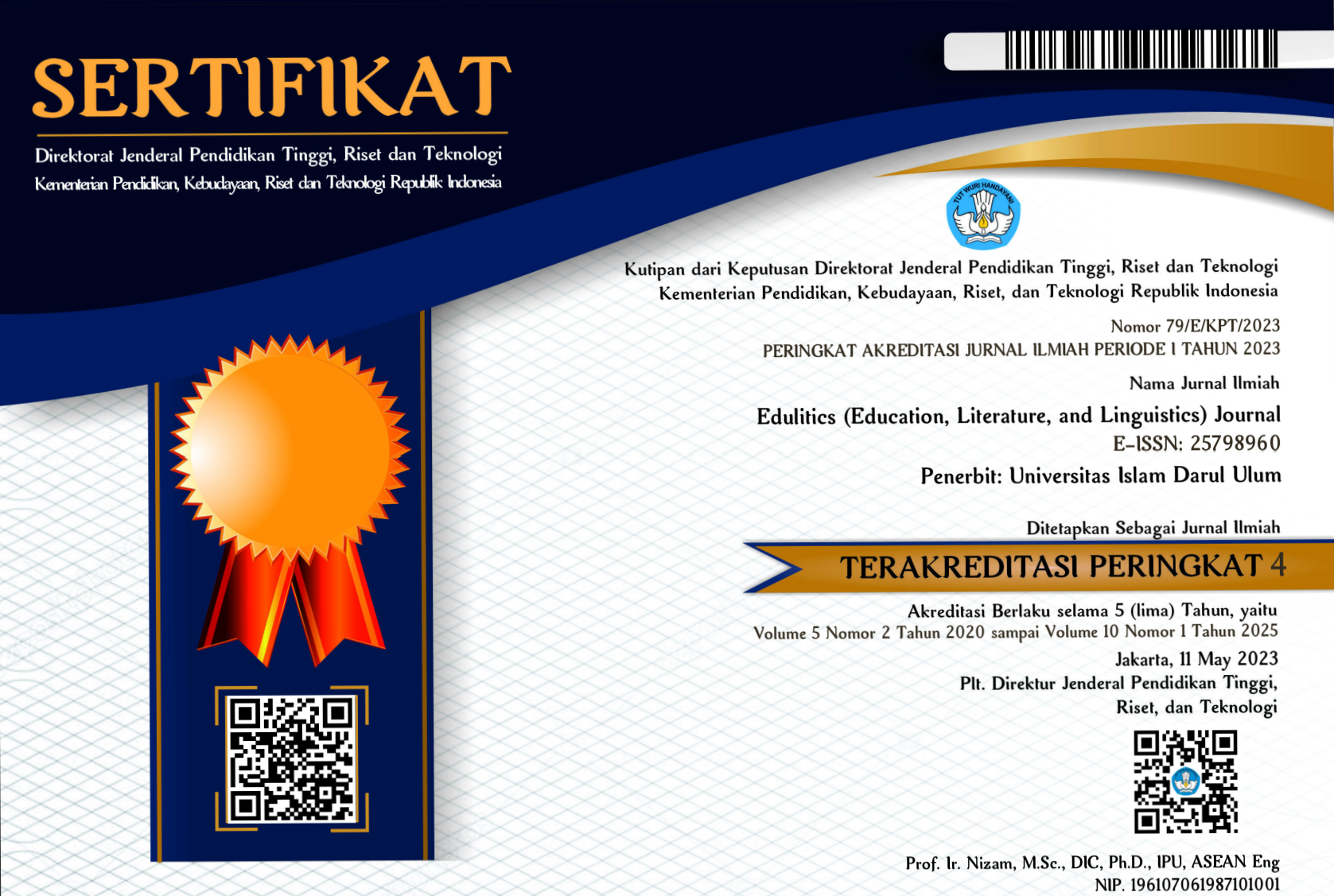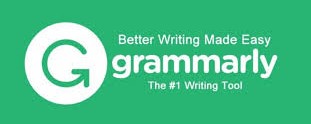The Effect of Using Self-Assessment Technique towards EFL Students’ Writing Skill
Abstract
This study aims to identify the students’ writing skills before and after using the Self-assessment technique in narrative text and to figure out the positive and significant effect of using the Self-assessment technique in students’ writing achievement narrative text. This research used Quasi-experimental research as a method, to get the data the researcher used a t-test as a research design. To collect the data from the two groups using the test through writing test in the form of simply writing to be used for pre-test and post-test. The researchers used two kinds of classrooms, experimental class, and controlled class. The researchers took 40 students as the sample. the researcher used statistical analysis for analyzing the data. Statistical analysis that the researcher used to study the T-test is SPSS (Statistic Product And Statistic Solution) which examines the significant difference in students’ writing skills between the experimental and control group. The research finding shows that the effect of using the self-assessment technique on students’ writing skills is effective. Based on the t-test result shows that the mean score of the experimental is higher than the control class which obtained 64.50 and the control class obtained a 54.50 score. Furthermore, the result of the data normality test, homogeneity test, and hypothesis test which are claimed that the self-assessment technique has a significant effect on students’ achievement in writing narrative text. Self-assessment was helpful in classroom activity as an experimental class did it. It is also indicated by the higher total scores of students’ writing after the practice of Self-assessment.
Downloads
References
Andrade, H. L. (2019). A critical review of research on student self-assessment. In Frontiers in Education (Vol. 4, p. 87). Frontiers.
Albayram, Emine. (2017). Impact of English as a foreign language students’ self-assessment on their writing skills’ development. Journal of Education in Black Sea Region, 2(2), 56-87.
Alderson, M., & Anderson, K. (2003). Text Types in English 3. South Yarra Macmillan Education Australia.
Al-Mahrooqi, R., Coombe, C., Al-Maamari, F., & Thakur, V. (Eds.). (2017). Revisiting EFL Assessment: Critical Perspectives. Springer.
Assis, B. M. D. (2012). Self-assessment of writing skills: a reliable and valid tool in an efl classroom (Doctoral dissertation, Faculdade de Ciências Sociais e Humanas, Universidade Nova de Lisboa).
Bing, XU. (2016). A Study of the Effects of Student Self-assessment on the EFL Writing of Chinese College Students. Journalism, 6(2), 91-107.
Brown, H. D. (2007). Principles of language learning and teaching fifth edition. White Plains, NY: Pearson Education.
Brown, G., & Harris, L. R. (2013). Student self-assessment. SAGE handbook of research on classroom assessment.
Cahyono, B. Y & Taufik. M. (2019). Developing EFL Students’ Writing Skill through Self-Assessment Integrated with E-Portfolio. IJEE (Indonesian Journal of English Education), 6 (2), 171-186.
Cheng, F. & Chen, Y. (2009). Taiwanese argumentation skills: Contrastive rhetoric perspectives. Taiwan International ESP Journal, 1(1), 23-50.
Chelli, S. (2013). Developing Students' Writing Abilities by the Use of Self-Assessment through Portfolios. Arab World English Journal, 4(2).
Creswell John, W. (Eds). (2014). Research Design: Qualitative, Quantitave, and mixed method approaches. Sage.
Earl, L. M. (2013). Assessment as Learning: Using classroom assessment to maximize student learning. Thousand Oaks, CA: Corwin Press.
Fahimi, Z. & Rahimi, A. (2015). On the impact of self-assessment practice on writing skill. Procedia - Social and Behavioral Sciences, 192, 24, p. 730 – 736.
Farrell, M. (2012). The special education handbook: an AZ guide. Routledge.
Fitzpatrick, B., & Schulz, H. (2016). Teaching young students to self-assess critically. In annual meeting of the American Educational Research Association, Washington DC.
Gardner, D. (2000). Self-assessment for autonomous language learners. Links & Letters, (7), 049-60.
Gardner, J., Harlen, W., & Hayward, L. (2010). Developing teacher assessment. McGraw-Hil Education (UK).
Harmer, J. (2006). How to teach writing. Pearson Education India.
Heidarian, N. & Bonyadi, A. (2016). Investigating the effect of using self-assessment of Iranian EFL learners’ writing. Journal of Education and Practice. 28(7), 80-89.
Indriati, T. (2015). Improving writing skills on narrative texts for grade VIII E students of SMPN 6 Magelang through collaborative writing technique in the academic year of 2014/2015.
Javaherbaksh, M. R., (2010). Impact of self-assessment on Iranian EFL learners’ writing skills. English Language Teaching. 3(2), 213-218.
Khodadady, E., & Khodabakhshzade, H. (2012). The effect of portfolio and self-assessment on writing ability and autonomy. Journal of Language Teaching and Research, 3(3), p. 518-524.
Lande, Shyla K. & Astuti, Eka M. (2015). Forward for Vocational School Grade X. Jakarta: Erlangga.
Lam, R. (2010). The role of self-assessment in students’ writing portfolios: A classroom investigation. TESL Reporter, 43(2), 16-34.
McMillan, J. H., & Hearn, J. (2008). Student self-assessment: The key to stronger student motivation and higher achievement. Educational Horizons, 87(1), 40-49.
Manchon, Rosa M. (2009). Writing in Foreign Language Contexts: Learning, Teaching, and Research. Multilingual Matters.
Nagel, M., & Lindsey, B. (2018). The Use of Classroom Clickers to Support Improved Self-Assessment in Introductory Chemistry. Journal of College Science Teaching, 47(5), 72-79.
Nicol, D. J., & Macfarlane‐Dick, D. (2006). Formative assessment and self‐regulated learning: A model and seven principles of good feedback practice. Studies in higher education, 31(2), 199-218.
Nimehchisalem, V., Yoong, D. S. C., Kaur, S. J. S., Siti Zaidah, Z., Norouzi, S., & Sheren, K. (2014). A self-assessment checklist for undergraduate students’ argumentative writing. Advances in Language and Literary Studies, 5(1), 2203-4714.
Purwanti. (2013). Let’s Write English Text. Yogyakarta: PT Citra Aji Paranama.
Puspitaloka, N., & Wahyuna, Y. T. (2018). Kesulitan-kesulitan yang dihadapi mahasiswa PIAUD dalam pembelajaran Bahasa Inggris. AWLADY: Jurnal Pendidikan Anak, 4(2), 120-136.
Raaijmakers, S. F., Baars, M., Paas, F., van Merriënboer, J. J., & van Gog, T. (2019). Effects of self-assessment feedback on self-assessment and task-selection accuracy. Metacognition and Learning, 14(1), 21-42.
Renandya, W. A., & Widodo, H. P. (Eds.). (2016). English language teaching today: Linking theory and practice (Vol. 5). Springer.
Richards, J. C., & Renandya, W. A. (Eds.). (2002). Methodology in language teaching: An anthology of current practice. Cambridge university press.
Roca de Larios, J., Manchon, R.M., Murphy, L., & Marin, J. (2008). The Foreign Language Writer’s Strategic Behaviour in the Allocation of Time to Writing Process. In Manchon, Rosa M. (2009). Writing in Foreign Language Contexts: Learning, Teaching, and Research. Multilingual Matters.
Spiller, D. (2009). Assessment Matters: Self-Assessment and Peer Assessment. Teaching Development, The University of Waikato.
Spratt, M., Pulverness, A., & Williams, M. (2011). The TKT course. Ernst Klett Sprachen.
Sugiyono. (2017). Metode Penelitian Pendidikan (Pendekatan Kualitatif, Kuantitatif dan R&D). Bandung: Penerbit Alfabeta.
Takarroucht. K. (2022). The Effect of Self-Assessment on the Development of EFL Writing Self-Efficacy: A Case of Algerian Higher Education. International Journal of Language Education, 6(2), 157-168.
Theresia Putri, P. (2015). The implementation of self-assessment in writing class: Case study STIB LIA Jakarta. Teflin Journal, 26(1), 97-116.
Thompson, B. (2006). Foundations of Behavioral Statistics: An Insight-Based Approach. New York: Guilford.
Tiwari. (2005). What is writing. http//www.teaching.org.uk/think/write/diary.htm. accessed on January 31th, 2019.
Tuleya, L. G. (2007). Thesaurus of Psychological Index Terms. Washington, DC: APA. van Kraayenoord, C. E., & Paris, S. G. (1997). Australian students' self-appraisal of their work samples and academic progress. The Elementary School Journal, 97(5), 523-537.
Urqurhart, V. & Mclever, M. (2005). Teaching Writing in The Content Areas. Virginia: ASCD.
Wardiman, Artono et.al. (2008). English in Focus. Jakarta: Pusat Perbukuan; Depdiknas.
Wisnu. C & Pradana. S. A. (2020). Students’ Self-Assessment in Article Writing Class. English Education: Jurnal Tadris Bahasa Inggris, 13 (1), 15-31.

This work is licensed under a Creative Commons Attribution-ShareAlike 4.0 International License.
Authors retain copyright and grant the journal the right of first publication with the work simultaneously licensed under a Creative Commons Attribution-ShareAlike 4.0 International License that allows others to share the work with an acknowledgment of the work's authorship and initial publication in this journal.
Authors are able to enter into separate, additional contractual arrangements for the non-exclusive distribution of the journal's published version of the work (e.g., post it to an institutional repository or publish it in a book), with an acknowledgment of its initial publication in this journal.
Authors are permitted and encouraged to post their work online (e.g., in institutional repositories or on their website) before and during the submission process, as it can lead to productive exchanges and earlier and greater citation of published work.






_(1).png)


